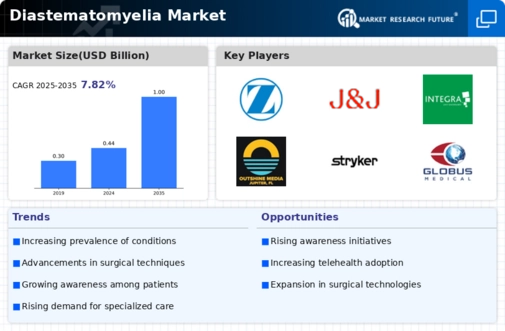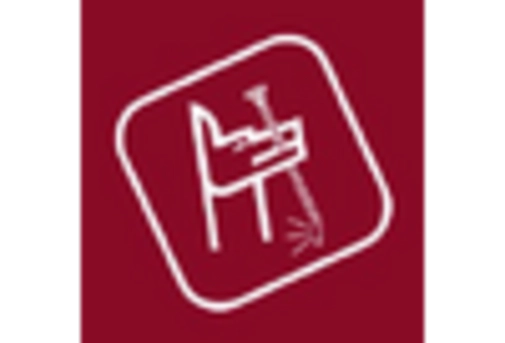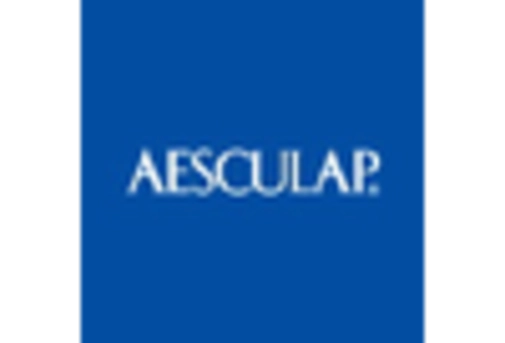Market Growth Projections
The Global Diastematomyelia Market Industry is poised for substantial growth, with projections indicating a market value of 0.44 USD Billion in 2024 and an anticipated increase to 1 USD Billion by 2035. This growth trajectory suggests a compound annual growth rate (CAGR) of 7.75% from 2025 to 2035. Such figures reflect the increasing demand for effective treatment options and the ongoing advancements in medical technology and healthcare infrastructure. The market's expansion is indicative of a broader recognition of diastematomyelia and the necessity for specialized care, positioning the industry for a promising future.
Advancements in Medical Technology
Technological advancements in medical imaging and surgical techniques are driving the Global Diastematomyelia Market Industry forward. Innovations such as MRI and CT scans enhance diagnostic accuracy, allowing for earlier detection of diastematomyelia. Furthermore, minimally invasive surgical techniques are improving patient outcomes and reducing recovery times. These advancements not only facilitate better management of the condition but also encourage healthcare providers to adopt new treatment protocols. As a result, the market is projected to grow significantly, with an anticipated CAGR of 7.75% from 2025 to 2035, indicating a robust future for the industry.
Increasing Prevalence of Diastematomyelia
The Global Diastematomyelia Market Industry is experiencing growth due to the rising prevalence of diastematomyelia, a rare congenital spinal condition. As awareness increases among healthcare professionals and the general public, more cases are being diagnosed. Reports indicate that the number of diagnosed cases is expected to rise, contributing to market expansion. In 2024, the market is valued at approximately 0.44 USD Billion, reflecting the urgent need for effective treatment options and management strategies. This trend suggests a growing demand for specialized medical services and interventions tailored to this condition.
Emergence of Specialized Treatment Centers
The emergence of specialized treatment centers dedicated to managing diastematomyelia is a notable trend within the Global Diastematomyelia Market Industry. These centers offer comprehensive care, including diagnosis, surgical intervention, and rehabilitation tailored to the unique needs of patients. By concentrating expertise and resources, these facilities enhance treatment outcomes and patient satisfaction. The establishment of such centers is likely to attract more patients seeking specialized care, thereby driving market growth. As the industry evolves, the presence of these centers may play a pivotal role in shaping treatment paradigms and improving overall patient experiences.
Rising Awareness and Education Initiatives
The Global Diastematomyelia Market Industry is benefiting from rising awareness and education initiatives aimed at both healthcare professionals and the public. Campaigns focused on congenital disorders are helping to demystify conditions like diastematomyelia, leading to earlier diagnosis and treatment. Educational programs for medical practitioners enhance their ability to recognize symptoms and provide appropriate care. This increased awareness is likely to contribute to a growing patient population seeking treatment, thereby expanding the market. As more individuals become informed about the condition, the demand for specialized services is expected to rise, further propelling market growth.
Growing Investment in Healthcare Infrastructure
Investment in healthcare infrastructure is a crucial driver for the Global Diastematomyelia Market Industry. Governments and private entities are increasingly allocating resources to improve healthcare facilities and services, particularly in regions with high incidences of congenital disorders. Enhanced infrastructure leads to better access to diagnostic and treatment options for patients suffering from diastematomyelia. This trend is expected to support market growth, as improved healthcare systems can facilitate timely interventions. By 2035, the market is projected to reach 1 USD Billion, reflecting the positive impact of these investments on patient care and outcomes.






















Leave a Comment